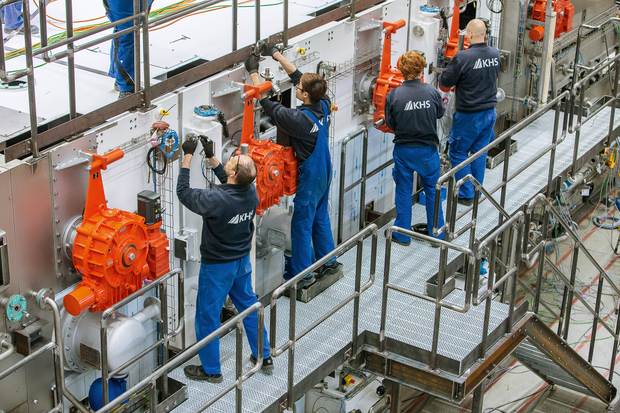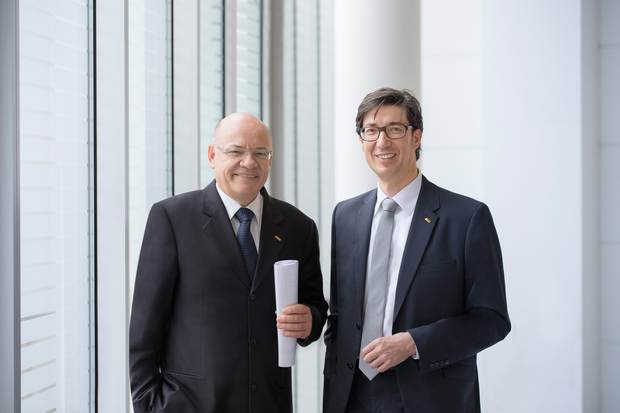Pasteurization involves briefly heating beverages to moderate temperatures of up to 75°C to reduce microorganisms and deactivate enzymes. Unlike sterilization, which requires temperatures of at least 100°C, both taste and nutritional values are barely affected by pasteurization.
During flash pasteurization the beer is fed from the storage cellar to the flash pasteurizing system at a temperature of 4°C and a pressure of 3 bar. In the plate heat exchanger hot water flows on the opposite side of the beer flow which warms the beer up to a temperature of 72°C, for example. As the beer develops a high pressure due to its CO₂ content, it must be pressurized to a suitably high positive pressure with the help of a pressure booster pump which prevents a loss of carbon dioxide. No gas bubbles must be allowed to form in the product where microorganisms could become encapsulated which are then not destroyed – and thus spoil the beer.
In order to ensure maximum product safety the pasteurization process is continuously monitored and recorded. After specifically retaining the heat of the product for 30 seconds, for instance, energy is exchanged with the fed-in product in the regenerative section of the plate heat exchanger. By recovering 90% of the heat the product reaches a discharge temperature of about 11°C. Depending on the required filling temperature an active interim cooling stage may have to be installed. The beer is then temporarily stored as sterile beer in the buffer tank which serves as a flexible performance ramp and saves CO₂ by ensuring that pressure is maintained for the continuous supply of the filling process in the connected bottle filler or keg racker.
Little brother
In addition to its successfully launched Innopro KZE C flash pasteurizer with a capacity of 20 to over 600 hectoliters per hour, Dortmund systems provider KHS now also presents a machine which at an output of 45 hectoliters an hour is tailored to meet the requirements of SMEs. The process is the same as that used by its big brother but the Innopro BoxFlash is convincing with its comparably low investment and logistics costs, high energy efficiency, compact design, simple installation and fast commissioning. The Innopro BoxFlash has been specifically geared towards the requirements of the KHS CombiKeg filler –right down to the preparation of media such as CO₂ or compressed air which is managed jointly for both system components on the BoxFlash flash pasteurizer frame.
The Innopro BoxFlash system can also be equipped with an optional OnBoard CIP module. Thanks to this unique combination, after production both the BoxFlash pasteurizer and CombiKeg filler can be internally sanitized without the need for an external CIP system. Two container parking stations and CIP media dosing pumps have been integrated into the BoxFlash pasteurizer for the supply of CIP media. Thanks to the optimized process design and compact array with the filler the entire system volume can be kept so low so as to cut down CIP times for the flash pasteurizer and CombiKeg filler to a minimum, thus readying the system for production again very quickly.
Lower cost of investment
One of the requirements was that it should be easy for smaller breweries to manage the investment in the machine by using components from other serial machines, such as the buffer tank and frame from the Innopro Paramix series, the pioneering two-component blending system from KHS. The proven sled systems for product pumps are also included that facilitate maintenance considerably. All of these measures to use the same components in KHS process engineering enable further savings which result in a lower cost of investment for the customers who purchase the machinery.
The machine has a high energy efficiency, not least thanks to its plate heat exchanger which recovers at least 90% of the heat. The pasteurization temperature is between 60 and 75°C and the heat holding time is 30 seconds. The required pasteurization units (PU) – ultimately a play with temperature and the duration of pasteurization – can thus be specifically and precisely obtained for beer.
One of special features of the Innopro BoxFlash is the fact that the buffer tank is not outside the system as is usual but has been placed inside the frame which is exactly dimensioned to fit inside a container. Alfons Abels-Rümping, head of Development & Product Management at KHS in Bad Kreuznach, explains how this works and which benefits this has for the customer. “In order to develop this compact system we only had to reduce the size of the tanks by 25% down to a still generous 1,500 liters. As a result, the systems don’t have to be dismantled for shipping, supplied in parts and repiped and rewired on site, meaning that after acceptance here at our factory they can effectively be shipped as a complete unit.” This reduces logistics costs by at least two thirds and cuts installation time on site to the absolute minimum. “At the machine’s final destination all that has to be done is to attach the machine feet and mount the overpressure valve which secures the buffer tank. As soon as the beer, steam, and media lines have been connected, the Innopro BoxFlash is immediately ready for operation.”
Your contact on this topic
Alfons Abels-Rümping
Head of Development & Product Management
KHS GmbH, Bad Kreuznach, Germany
Phone: +49 671 852 2211
Email: alfons.abels-ruemping@khs.com
























